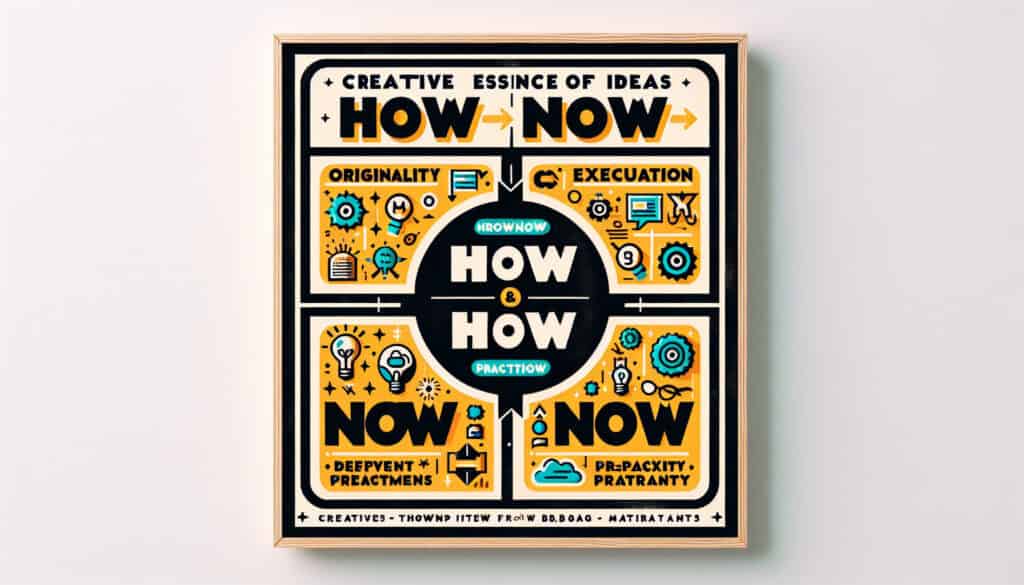To categorize and prioritize ideas based on their originality and feasibility.
- Méthodologies : Ergonomie
How-Now-Wow Matrix

How-Now-Wow Matrix
- Méthodologie Agile, Remue-méninges, Créativité, Pensée conceptuelle, Idéation, Innovation, Gestion de projet, Prototypage, User-Centered Design
Objectif :
Comment il est utilisé :
- A 2x2 matrix used to evaluate ideas based on two criteria: feasibility (how easy it is to implement) and originality (how innovative it is). Ideas are plotted on the matrix as 'How' (innovative but not feasible), 'Now' (easy to implement but not original), or 'Wow' (both innovative and feasible).
Avantages
- Simple and easy to understand; Helps to prioritize ideas and focus on the most promising ones.
Inconvénients
- Can be subjective and depend on the criteria used; May stifle creativity by focusing too much on feasibility.
Catégories :
- Idéation, Gestion de projet
Idéal pour :
- Prioritizing ideas in a brainstorming session to identify those that are both innovative and actionable.
The How-Now-Wow Matrix serves as an effective tool in various settings such as workshops, product development phases, and innovation sessions across industries like consumer electronics, automotive, healthcare, and software development. Its practicality shines in early-stage brainstorming sessions, enabling teams to visualize and categorize ideas efficiently, thus avoiding lengthy debates on each concept. Typically, project stakeholders, including designers, engineers, marketing teams, and management, gather to contribute and assess ideas collaboratively. By using the matrix, teams can quickly identify which ideas fall into the ‘Wow’ category, which combine high feasibility with strong innovation, allowing them to prioritize these ideas for further exploration and development. This not only accelerates the decision-making process but also fosters a culture of innovation, as team members can see where their creative thoughts fit within the broader scope of the project. Various applications include developing new product features, solving engineering challenges, enhancing service delivery methods, and even mapping out marketing strategies. The method’s straightforward, visual approach facilitates discussions, encourages participation, and contributes to the alignment of the team’s goals, making it a favored choice for organizations eager to innovate within budget and time constraints.
Principales étapes de cette méthodologie
- Generate a list of ideas through brainstorming.
- Evaluate each idea for feasibility by assessing required resources and potential obstacles.
- Evaluate each idea for originality considering its innovative qualities and uniqueness.
- Plot each idea on the 2x2 matrix according to its feasibility and originality ratings.
- Identify ideas in the 'Wow' quadrant as top priorities for development.
- Select ideas from 'Now' for immediate implementation.
- Consider 'How' ideas for potential future development with further investigation.
- Discern if any 'Wow' concepts can be made more feasible through adaptation.
Conseils de pro
- Involve cross-disciplinary teams to enrich the discussion and generate diverse viewpoints, ensuring a broader range of innovative ideas.
- Use a scoring system to quantify feasibility and originality, allowing for more objective placement of ideas on the matrix. <li Regularly revisit and update ideas based on new data or changing contexts, keeping the matrix relevant to evolving industry standards.
Lire et comparer plusieurs méthodologies, nous recommandons le
> Référentiel méthodologique étendu <
ainsi que plus de 400 autres méthodologies.
Vos commentaires sur cette méthodologie ou des informations supplémentaires sont les bienvenus sur le site web de la Commission européenne. section des commentaires ci-dessous ↓ , ainsi que toute idée ou lien en rapport avec l'ingénierie.
Contexte historique
1949
1950
1950
1960
1960
1960
1960
1940
1950
1950
1958
1960
1960
1960
1960
(si la date est inconnue ou n'est pas pertinente, par exemple "mécanique des fluides", une estimation arrondie de son émergence notable est fournie)















Articles Similaires
Calculateur de METS en calories
Méta-analyse
Cartographie des messages
Diagrammes du modèle mental
Forces de poussée et de traction maximales acceptables
Planification des besoins en matériaux (MRP)